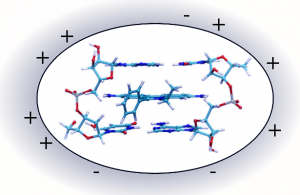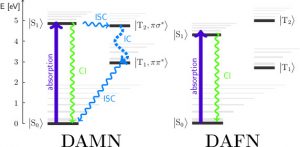W. Bartkowiak, R.W. Góra, J. Kozłowska, A. Roztoczyńska, K. Strasburger, R. Zaleśny
One of the main research topics in our group are linear and nonlinear electro-optic properties of molecules and molecular aggregates, as well as the influence of external confining potentials on these properties. Our research interests focus on theory and computations of electronic and vibrational (hyper)polarizabilities, simulations of multiphoton absorption in organic compounds, electronic structure and properties of π-conjugated systems, interaction-induced (hyper)polarizabilities of molecular clusters and theory and computations of solvent effects on molecular properties.

Intermolecular interactions
W. Bartkowiak, R.W. Góra, J. Kozłowska, P.Lipkowski, A. Roztoczyńska, R. Zaleśny
Theory of intermolecular interactions and computational studies of properties of weakly bound complexes is also a major subject of our studies. These include development of ab initio methods for analysis of intermolecular interactions in molecular complexes, including open shell and excited state species; studies of the influence of external potential on intermolecular interactions via effective Hamiltonian approach combined with approximate models of solvent (PCM, SCRF) and effective fragment potentials (EFP); studies of nonadditivity of intermolecular interactions; studies on the stepwise solvation of molecular anions; and applications of the quantum theory of atoms in molecules (QTAIM) in studies of intermolecular interactions, focusing on the hydrogen-bonded systems.
Formalism and applications of explicitly correlated wave functions
K. Strasburger
Research interests of Dr. Krzysztof Strasburger are in the formalism of explicitly correlated wave functions and its applications in studies of stability and properties of positronic atoms and molecules, interaction of antihydrogen with normal matter and electrooptic properties of spatially confined molecules.

Photochemistry and photophysics of prebiotically relevant systems
R.W. Góra
One of the key factors that influenced the abiogenesis and evolution of first living organisms, was the unattenuated UV radiation. The first living organisms would be based on π-electronic macromolecules, susceptible to UV radiation induced damage that reached these molecules unattenuated through cell structures. These macromolecules probably would not have had the UV repair mechanisms present in contemporary living organisms. Thus UV radiation was an important selective factor, and an efficient energy source, driving the early stages of abiogenesis. In our studies we investigate photostability of molecules relevant to prebiotic chemistry and other relevant UV-induced processes.
